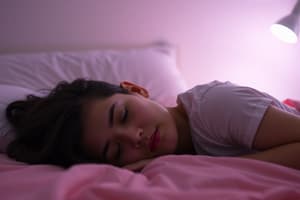Podcast
Questions and Answers
What did Dr. Thomas Wehr discover about sleep patterns during his experiment?
What did Dr. Thomas Wehr discover about sleep patterns during his experiment?
- All participants slept for eight consecutive hours.
- People fell asleep immediately after going to bed.
- Most people stayed awake for two hours before sleeping. (correct)
- People were able to sleep continuously without interruptions.
In what unique condition did Dr. Wehr conduct his sleep experiment?
In what unique condition did Dr. Wehr conduct his sleep experiment?
- The room had ambient light from candles.
- The room was completely dark with no artificial light. (correct)
- Participants were required to engage in physical activity.
- Participants were allowed to use electronic devices.
After the initial sleep period, how long did participants typically remain awake before sleeping again?
After the initial sleep period, how long did participants typically remain awake before sleeping again?
- Less than one hour.
- One to three hours. (correct)
- Seven to eight hours.
- Five to six hours.
How did sleep patterns in the past differ from those observed in Dr. Wehr's study?
How did sleep patterns in the past differ from those observed in Dr. Wehr's study?
What advice is given for those who wake up in the middle of the night and cannot sleep?
What advice is given for those who wake up in the middle of the night and cannot sleep?
Flashcards are hidden until you start studying
Study Notes
Sleep Patterns and Dr. Wehr's Research
- Experiment conducted by Dr. Thomas Wehr focused on natural sleep patterns without modern lighting.
- Participants were placed in a dark room without exposure to lamps, TVs, or computers during winter.
- Initial sleep pattern observed involved staying awake for approximately two hours before falling asleep.
- Main sleep duration lasted four to five hours after the initial wakefulness.
- Post-sleep, individuals remained awake for one to three hours before sleeping again for another four to five hours.
- This pattern indicates a biphasic sleep cycle: two sleep periods divided by a waking period.
Historical Context of Sleep
- Dr. Wehr's findings suggest this biphasic sleep pattern may reflect historical norms before the invention of electric light.
- In pre-electric light societies, it was common for people to experience segmented sleep cycles.
- Contemporary sleep practices differ significantly, often resulting in uninterrupted nights of sleep.
Implications on Modern Sleep
- Understanding natural sleep patterns can alleviate concerns about waking during the night.
- Recognizing that these interruptions may not be problematic can encourage relaxation rather than anxiety.
- Encourages a shift in perspective: occasional wakefulness at night can be considered a normal part of the sleep cycle.
Studying That Suits You
Use AI to generate personalized quizzes and flashcards to suit your learning preferences.




